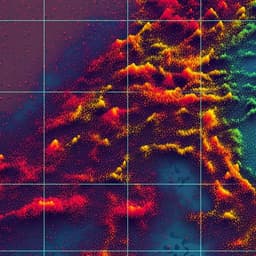
Engineering and Technology
Low cost exoskeleton manipulator using bidirectional triboelectric sensors enhanced multiple degree of freedom sensory system
M. Zhu, Z. Sun, et al.
Discover an innovative low-cost, energy-efficient exoskeleton system that utilizes bidirectional triboelectric sensors for real-time monitoring of human upper limb movements. This groundbreaking research, conducted by Minglu Zhu, Zhongda Sun, Tao Chen, and Chengkuo Lee, opens new possibilities in robotic automation, healthcare, and training.
~3 min • Beginner • English
Introduction
The study addresses the need for low-cost, low-power, and less complex human-machine interfaces capable of accurately tracking multi-degree-of-freedom (DOF) upper-limb motions for parallel control of robots and virtual objects. Conventional HMIs using inertial or resistive sensors face drawbacks such as heavy data processing, temperature dependence, and higher power consumption; vision systems require unobstructed environments and raise privacy concerns. The authors propose integrating triboelectric bidirectional (TBD) sensors with a customized upper-limb exoskeleton to provide unified, self-powered sensing of rotational and linear motions across multiple joints, aiming to simplify hardware and signal processing while maintaining adequate resolution and responsiveness for real-time control in robotics and VR/AR. The work is important for applications in industrial automation, rehabilitation, training, and digital twin systems.
Literature Review
The paper surveys HMIs and wearable sensing technologies in the context of AIoT and 5G-enabled robotics and VR/AR. Commercial approaches include inertial, resistive, and capacitive sensors (e.g., gloves) that provide high sensitivity but require complex signal processing and can be power-hungry and temperature-dependent. Emerging flexible wearables and e-skins offer multifunctional sensing (pressure, temperature, humidity, etc.), with examples such as capacitive tactile arrays, ultrasensitive resistive gauges, multifunctional skin patches, hybrid piezoresistive/thermoelectric sensors, and optical fiber-based sensing gloves. Triboelectric and piezoelectric sensors have gained attention due to self-generated signals and low power consumption, with prior triboelectric gloves using contact-separation or sliding modes and machine learning for interpretation. Existing bidirectional triboelectric rotation sensors often use two-disc, multi-channel phase-difference architectures that increase size and complexity. Exoskeletons have mainly focused on actuation for assistance, with fewer works on integrating novel sensors for HMI; inertial-sensor-based exoskeletons generate large datasets, and vision-based methods have spatial constraints. The authors position their TBD approach as a unified, customizable, low-cost sensing mechanism that reduces channel count and processing complexity while improving spatial mapping through exoskeleton alignment with human joints.
Methodology
System design: The authors developed rotational and linear triboelectric bidirectional (TBD) sensors and integrated them into a 3D-printed upper-limb exoskeleton comprising five components (back supporter, L-shaped shoulder module, upper arm, forearm, and glove).
- Rotational TBD (RTBD) sensor: Composed of a shaft, a fly ring with a PTFE grating pattern, and a pendulum-style bistable switch with two electrodes (E1, E2) for direction discrimination. A copper spring on the switch provides compliant contact with the PTFE gratings and serves as the positive triboelectric material; the switch twists under shear to contact E1 or E2 depending on rotation direction, routing the pulse signals accordingly. Ring diameters: 7–8.5 cm; thickness: 2 cm. Variants: RTBD-B (back/shoulder abduction), RTBD-S (shoulder flexion/extension), RTBD-E (elbow flexion), RTBD-W (wrist twist, with U-shaped ring to pass around the forearm).
- Linear TBD (LTBD) sensor: A switch on a palm-mounted holder interfaces with a flexible FEP strip bearing PTFE gratings. Finger bending translates to linear motion of the strip, twisting the switch to contact E1/E2 for direction and producing pulses.
Working principle: Sliding of the copper spring across each PTFE grating alters contact electrification area, generating a pair of charge transfer events per grating and output pulse peaks. Direction is determined by which electrode (E1/E2) is contacted by the twisted switch. For linear sensing, pulling/pushing the FEP strip during finger flexion/extension similarly biases the switch.
Optimization and characterization:
- RTBD grating width study: PTFE strip widths 1, 3, 5, 7 mm at fixed spacing 3 mm (gratings count over 0°–90°: 12, 9, 6, 5). Tested at 10–300 RPM. Signal amplitude increased with RPM; at 10 RPM, average peak ~0.4–1 V increasing with width; at 300 RPM, peaks up to ~18 V for 5–7 mm widths. Selected width 3 mm as a balance between resolution and signal strength.
- RTBD spacing study (constant width 3 mm): spacings 1, 2, 3 mm (gratings across 0°–110°: 14, 12, 9). Amplitude increased with RPM; narrower spacing reduced charge transfer time and peak amplitude, with occasional peak loss at 300 RPM for 1 mm spacing. Recommended adapting spring size to avoid overlap at high speeds. Achievable angular resolution ~4° for an 8.5 cm diameter sensor with 1 mm width and 1 mm spacing; typical implementation used 10° per grating with 3 mm width/spacing.
- Reliability: 3-hour test at 100 RPM with 18 gratings showed stable peaks above threshold. Environmental robustness: Signals decayed at 95% RH but remained detectable via thresholded peak counting.
- LTBD characterization: PTFE width 2 mm; spacings 1, 2, 3 mm. For 90° finger bend, observed 5, 4, 3 peaks respectively; average peak ~0.2 V; bidirectional operation confirmed.
- Switch response latency: Gap sizes 1.5 and 3 mm evaluated using auxiliary contact-separation indicators at E1/E2. Switching delay (separation-to-contact) on direction change was a few milliseconds even at 10 RPM, indicating negligible latency.
Signal processing: A preprocessing circuit (LM358 amplifier, LT1017 comparator) converts variable triboelectric pulses to digital square waves with tunable thresholds to suppress noise and handle slow motions. An Arduino microcontroller counts peaks per direction channel; Python receives serial data for higher-level processing and forwards commands (including hex-formatted for robot controllers) to Unity for visualization or to robot servo controllers for actuation.
Demonstrations:
- Virtual character control: Real-time projection of upper-limb motions with joint ranges: 120° side raise (RTBD-B), 180° forward lift (RTBD-S), 200° elbow bend (RTBD-E), 270° wrist twist (RTBD-W), 90° finger bend (LTBD-F). Mapping typically 10° per peak (configurable).
- Robotic control: Two 5-DOF human-like robotic arms controlled to pick up a cube and place it in a box using coordinated joint sequences, with real-time sensor channel logs.
- Ping-pong training: Recognition of four strikes (forehand stroke, left/right sidespin, smash) by joint-specific activation patterns; used to monitor motion correctness and enable training feedback.
Kinetic analysis and force estimation: Using pulse intervals tp to estimate instantaneous RPM; exoskeleton geometry aligns sensor locations with human joints enabling kinematic modeling. For a straight punch, with arm segments L1 (upper arm) and L2 (forearm) and joint angles α (upper arm vs centerline), β (forearm vs centerline), γ (elbow angle), the fist displacement and velocity were derived from α and ωs (shoulder angular velocity) obtained from RTBD sensors. Maximum computed fist linear velocity occurs around α ≈ 60°. Punching force estimated via momentum conservation using fist stopping time tc; validated against a punch force meter.
Key Findings
- A single-switch, single-grating triboelectric bidirectional sensor architecture enables bidirectional detection of rotational and linear motions without multi-disk, multi-channel phase comparison, simplifying hardware and programming.
- RTBD performance: Stable bidirectional sensing from 10 to 300 RPM; pulse amplitude increases with RPM (e.g., up to ~18 V at 300 RPM with 5–7 mm gratings). Selected 3 mm width and 3 mm spacing as a practical trade-off; higher resolution achievable (down to ~4° per step) with 1 mm width/spacing and microfabrication.
- Spacing effects: Narrow spacing (1 mm) can cause peak loss at 300 RPM due to incomplete charge transfer; proper spring sizing mitigates overlap. At 10–200 RPM, all spacings produced distinguishable peaks.
- LTBD: For 90° finger bending, observed 5, 4, 3 peaks for spacings 1, 2, 3 mm respectively; average peak ~0.2 V; reliable forward/backward detection.
- Response latency: Direction switching delay with 1.5 mm gap is on the order of milliseconds even at 10 RPM; 1.5 and 3 mm gaps both acceptable.
- Reliability and environment: 3-hour continuous test at 100 RPM with 18-grating device showed no significant signal degradation; peak counting with thresholds maintains function at 95% RH despite amplitude decay.
- Real-time applications: Demonstrated intuitive control of a virtual character and two robotic arms (5 motors each) for multi-step tasks (e.g., pick-and-place). Ping-pong training program successfully recognized forehand, left/right sidespin, and smash via joint-specific sensor activation sequences.
- Kinetic analysis: From RTBD pulse timing, instantaneous RPM and fist velocity computed; for 200 RPM punch, estimated fist velocity ~7.6 m/s, consistent with literature. Force estimation using stopping time yielded, for example, ~50 N at 1 m/s and ~87 N at 1.5 m/s; experimental force meter readings were ~40 N and ~90 N, respectively, indicating reasonable agreement with noted sources of error.
Discussion
The proposed exoskeleton-integrated TBD sensory system addresses the need for low-cost, low-power, and low-data-complexity HMIs by unifying sensing of multiple upper-limb DOFs through a single triboelectric switching mechanism. The ring-shaped RTBD and strip-based LTBD sensors provide directional pulse outputs proportional to angular or linear displacements, simplifying signal processing to peak counting with minimal preprocessing. The exoskeleton’s structural alignment with the human body enhances spatial accuracy and enables derivation of secondary kinematic parameters (velocity, displacement) and dynamic metrics (force) without adding sensor types. Compared to phase-based multi-disk triboelectric sensors, the design reduces size and complexity and expands functionality to both rotation and twist/linear motions. Demonstrations in VR control, robotic arm manipulation, and sports training show the system’s responsiveness and versatility. The ability to estimate velocity and force from the same signals broadens applicability to training and rehabilitation where quantitative feedback is valuable.
Conclusion
This work presents a low-cost, energy-efficient exoskeleton manipulator enabled by triboelectric bidirectional sensors that capture multidimensional upper-limb motions with minimal hardware and processing complexity. The unified RTBD/LTBD architecture supports real-time control of virtual avatars and robotic arms and, through kinematic analysis, estimates additional parameters such as velocity and punching force without extra sensors. Characterization confirms reliable bidirectional operation over 10–300 RPM, millisecond-scale switching latency, robustness over hours, and functionality under high humidity using thresholded peak counting. Future work includes microfabrication/MEMS techniques to increase grating density and precision, optimizing spring-contact geometries for higher-speed operation, extending the system to lower-limb exoskeletons for gait metrics (pace, speed, step length, stepping force), and scaling to parallel control of multiple robots within AIoT/5G infrastructures.
Limitations
- Peak loss at very high rotation speeds with narrow grating spacing due to incomplete charge transfer; requires spring/contact redesign for higher-speed operation.
- Signal amplitude degrades under high humidity (e.g., 95% RH), though thresholded peak counting remains functional; environmental sensitivity may impact SNR.
- Angular resolution in current 3D-printed implementations is limited (e.g., typical 10° per peak), with finer resolution requiring microfabrication of gratings and improved mechanical precision.
- Direction switching relies on a mechanical gap; although latency is small, gap design trades off robustness and sensitivity.
- Kinetic analysis uses simplifying assumptions (e.g., fixed shoulder torsion, estimated arm mass, simplified stopping time), introducing errors in force estimates; measured discrepancies were attributed to motion variability, meter resolution, and occasional peak detection loss.
- Wiring/body motion can introduce fluctuations; relies on preprocessing thresholds and comparators to mitigate noise.
Related Publications
Explore these studies to deepen your understanding of the subject.







